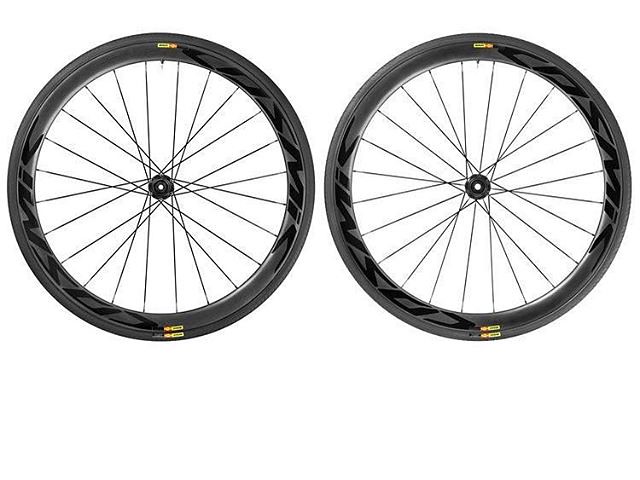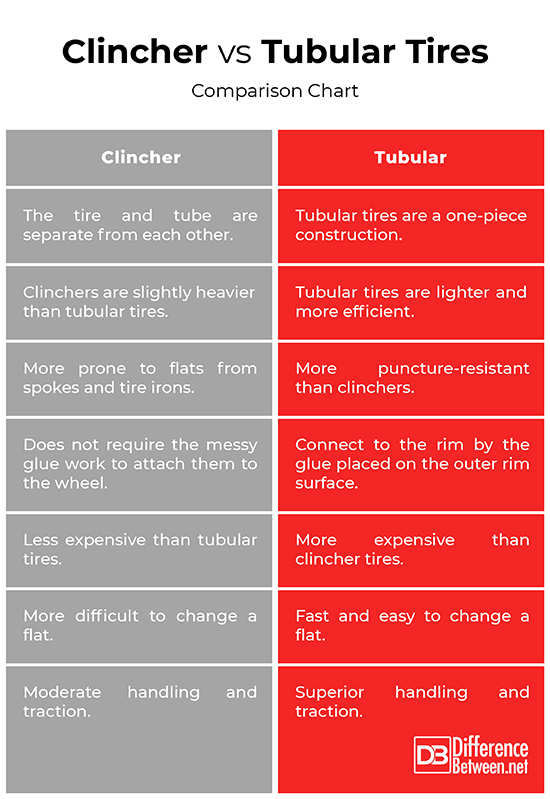Difference Between Clincher and Tubular
There are a few major considerations when it comes to choosing tires for your bike; tire pressure, tread pattern, and the tire width. But the one thing that matters the most is the tire type. Bike tires come in two most common varieties: clincher and tubular. Both refer to the type of tire that can be used on the wheel and the type of rim. Clincher, as the name implies, are the ones that work on clincher wheels, whereas tubular tires work only on tubular wheels. As a cyclist or a recreational biker, the very first choice you’ll have to make is to choose between clincher and tubular tires. Well, if you already have a bike and wheels, you’ll go for the ones that match with the type of wheels you already have. However, if you’re looking for a new pair of wheels, you will have to choose between the two. Each has its own set of pros and cons. We give you an in-depth look at the two types of tire with key differences to help you choose between the two.
What is Clincher?
Clincher wheels are the most common type of tires used and are the most ubiquitous in cycling. Clinchers are the more conventional design. The tire and tube are separate from each other and held to the rim by the wire-reinforced edges of the tire over the metal bead on the rim. They are held against the wheel by the shape of the rim, tension in the tire, and the pressure from the inflated tube. A clincher rim has side projections that hold the outer lining in place, with a central pneumatic tube used to inflate the tire. The tubes takes the space in the tire and the rim, when inflated, keeps the wire from popping off the rim. The tire bead is either made of steel wire or Kevlar strands.
What is Tubular?
Tubular tires are a one-piece construction with the ends sewn together on the inner, central portion. Tubular tires connect to the rim by the glue placed on the outer rim surface. There are open tubular tires that are essentially hybrids and are not stitched to hold the tube inside. Tubular tires are lighter, more efficient, and more puncture-resistant than clinchers. The main advantage of tubular tires is that they run effortlessly at low pressure without worrying of a pinch flat which is ideal in cyclocross racing. The total weight of the tire combined with the rim is lighter than its clincher counterpart, making it more efficient on the long run. Although, they look almost the same as the clincher tires on the outside, tubular tires have superior handling and traction compared to clinchers.
Difference between Clincher and Tubular
Design
Although, tubular tires look almost the same as the clincher tires on the outside, they are practically very different. Clinchers are the more conventional design and the tire and tube are separate from each other and held to the rim by the wire-reinforced edges of the tire over the metal bead on the rim. On the contrary, tubular tires are a one-piece construction with the ends sewn together on the inner, central portion and they connect to the rim by the glue placed on the outer rim surface.
Features of Clincher and Tubular
The main advantage of tubular tires is that they allow you to run at very low pressure, which is great when it comes to cyclocross racing. In addition, are lighter, more efficient, and more puncture-resistant than clincher tires. Plus, they have increased feel for the course and a highly reduced chance of pinch-flatting. Clincher tires, on the other hand, are cheaper, easier to fix, and you can easily mount and swap tires. Plus, you need not carry multiple wheelsets for changing conditions.
Maintenance
Clincher tires are easier to mount and it’s relatively easier to fix a flat. They are easier to deal with and maintain; you can easily mount and swap tires and you can change a tube to fix a flat. In addition, clinchers do not require you to carry multiple wheelsets for changing conditions, but unlike tubular, they lack the ability to run at very low pressures. One of the downsides of tubular tires is the increased labor in mounting and maintaining the tires, and the difficulty in swapping tires quickly based on conditions. So, clinchers clearly have a upper hand here when it comes to maintenance.
Clincher vs. Tubular Tires: Comparison Chart
Summary of Clincher vs. Tubular
In a nutshell, each type has its own set of pros and cons. Tubular tires are lighter, more efficient, and more puncture-resistant than clincher tires. Clincher tires, on the other hand, are the more conventional design and are cheaper, easier to fix, and do not require the messy glue work to attach them to the wheel. The best thing about tubular tires is that they allow you to run at very low pressure, making it a great deal in cyclocross racing. However, tubular are more difficult to maintain, especially when it comes to swapping tires. Plus, they are a little on the higher side, compared to clinchers. Tubular Tires connect to the rim by the glue placed on the outer rim surface, whereas clinchers connect by the outer tire clinching under the lip of the side projections of the rim.
- Difference Between Caucus and Primary - June 18, 2024
- Difference Between PPO and POS - May 30, 2024
- Difference Between RFID and NFC - May 28, 2024
Search DifferenceBetween.net :
Leave a Response
References :
[0]Heijmans, Jeroen and Bill Mallon. Historical Dictionary of Cycling. Lanham, Maryland: Scarecrow Press, 2011. Print
[1]Hobson, Wes, et al. Swim, Bike, Run. Champaign, Illinois: Human Kinetics, 2001. Print
[2]Gourley, Jim. FASTER: Demystifying the Science of Triathlon Speed. Boulder, Colorado: VeloPress, 2013. Print
[3]Image credit: https://www.flickr.com/photos/glorycycles/6522270413/in/photostream/
[4]Image credit: https://www.flickr.com/photos/glorycycles/31865195648



